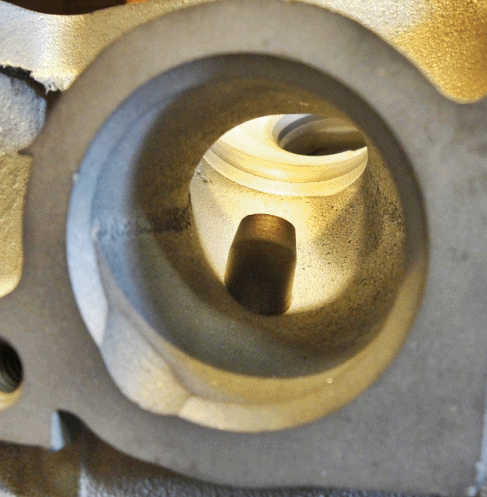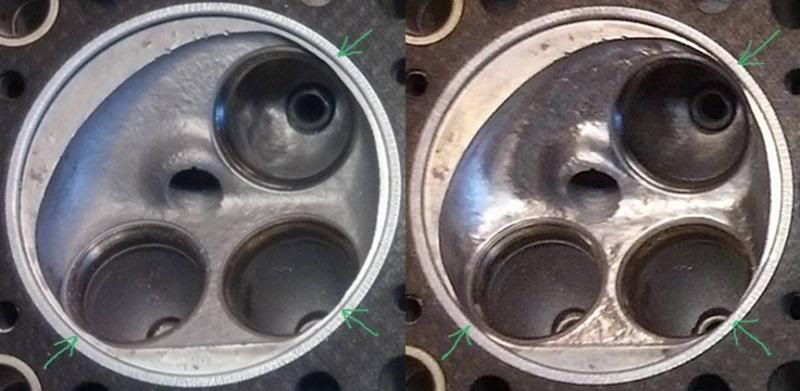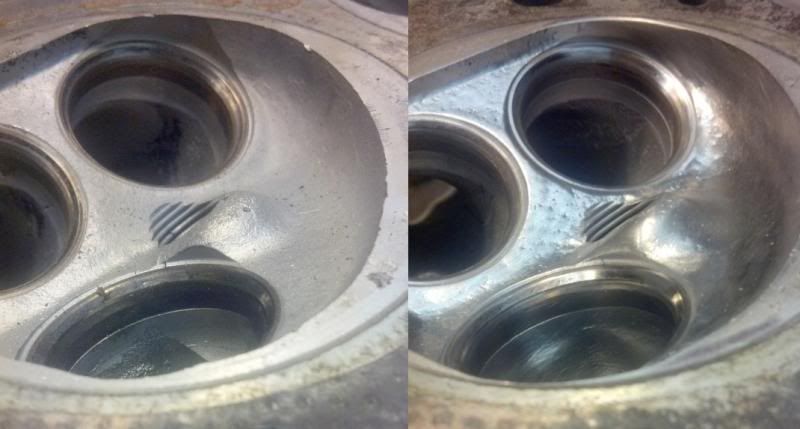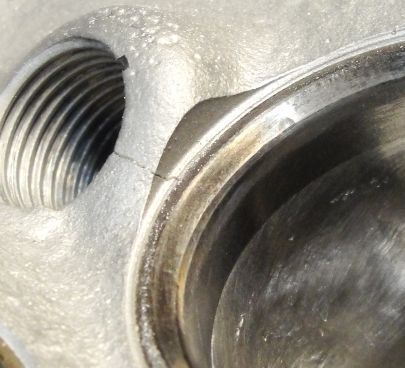
iadr wrote:Knurled wrote: I will leave this here... http://www.clubgti.com/showthread.php?146976-Modified-8v-project-headARRRGH.. sobbing. How can anyone get it that wrong? You do Not want a round port all along, it must start transitioning to oval immediately. He has ruined that casting.
While this is true, IIRC he was also making 200hp or so from an 8v engine, which is really close to as much as anyone has ever made from a production casting. (The F3 heads were... not production)
There are some significant limitations in effect with respect to where you can get area from, and the VW heads need all the area you can get. You can't go much wider without hitting head bolt holes, which "works" but makes the heads short-lived. The top of the port also runs raggedly close to the spring seats...
Like a lot of things, this is where theoretical perfect meets the limitations of what you have to work with. And there's a lot of limitations in a non-crossflow engine with a really short bore center, there's just no place in the head to put ports if you want to have a useful water jacket. (Which is also a problem)
In reply to oldeskewltoy: I tried to pm you with a porting question, but it came back as undeliverable.
On the subject of F2s, i found that the entire spark plug inclusion can be removed, so that's fun for future reference. It apparently ends up flowing so much more that the motor starts killing turbos because you end up over spinning it to attempt to hit the same boost levels.
HappyAndy wrote: In reply to oldeskewltoy: I tried to pm you with a porting question, but it came back as undeliverable.
oldeskewltoy at yahoo
Swank Force One wrote: On the subject of F2s, i found that the entire spark plug inclusion can be removed, so that's fun for future reference. It apparently ends up flowing so much more that the motor starts killing turbos because you end up over spinning it to attempt to hit the same boost levels.
![]()
Small turbos, that is. I wouldn't be worried on my setup. ![]()
Found a guy that has been running one like that for years. ![]()
How hard is it to port? I assume you use a fine dremel grinding stone and go slowly, but I may be wrong. How much of a gain would you see out of an SBC?
Great work OST. I can't imagine the difference that has to make. I did a simple gasket match and smoothing of casting marks on my old sr20 and it was a noticeable difference.
G_Body_Man wrote: How hard is it to port? I assume you use a fine dremel grinding stone and go slowly, but I may be wrong. How much of a gain would you see out of an SBC?
Depends on what you are porting.... cast aluminum, or cast iron.... I have no experience with cast iron, but I do know that there are differing aluminum compounds/alloys used. The 5MG head I'm now working is MUCH harder then newer Toyota multi valve castings, and it ("softer" mixtures) may be part of the infamous 7MG head gasket failures.....
As to what I use... carbide cutters of many different shapes and sizes, a few stones (not many), and sanding drums.... coarse - 80grit, and fine - 120grit - I use 1/4", 3/8" and 1/2".
As to what a beginner should use... I strongly recommend only the sanding drums.... and maybe a few fine narrow stones (tight access)
happyandy... got it... I'll get back to you in a day or two
G_Body_Man wrote: In reply to oldeskewltoy: I'm looking at an 84 SBC 305, so aluminum. Thanks for the tips!
305 SBC means small bore... tight valve fit, possible shrouding effect from cylinder walls... little chance of using big valves,so make it efficient. Also... from reading on the interwebz.... V8 head chamber volumes can vary by upto 5%. You don't want this, chamber volume equality makes for consistent power from all cylinders. Check your chamber volumes AFTER the valve job, and adjust accordingly.
If this is the first... keep your working mind set at "efficiency"... NOT power increases. Use plenty of light.... also always remember the direction of port flow...
You can not add material (at least not easily) DON'T overdue it. You have 16 ports - 8 of each, inspect them all before you touch any one.
Without before/after flow figures or dyno numbers, it's just pictures. Pretty pictures, but not necessarily a faster car.
There's an interesting thread about port texturing on Speedtalk right now... and a lot of "big names" are showing up to give their 2 cents.
What it boils down to is, some people say "It makes no difference in dyno or flow numbers" and the other people say "We don't find a difference on the dyno or flowbench either, but the engines do accelerate better and that's what matters"
Interesting point brought up by one of the BNs: On a steady state or fixed RPM rate dyno, you won't see a change, but on a fixed-load dyno that allows the engine to accelerate at its natural rate, you will see a difference. And some other things involving real time in-port and in-chamber inlet charge temperature measurement that he wasn't really forthright about...
In reply to dansxr2:
Check for valve shrouding... from what I can see, your head has some of this area that can be cleaned up....


also check for cracking between the exhaust valve and the spark plug hole.....

Knurled wrote: There's an interesting thread about port texturing on Speedtalk right now... and a lot of "big names" are showing up to give their 2 cents. What it boils down to is, some people say "It makes no difference in dyno or flow numbers" and the other people say "We don't find a difference on the dyno or flowbench either, but the engines do accelerate better and that's what matters" Interesting point brought up by one of the BNs: On a steady state or fixed RPM rate dyno, you won't see a change, but on a fixed-load dyno that allows the engine to accelerate at its natural rate, you will see a difference.
Most of the castings I've worked are bad enough that I can do substantial shaping without worrying about surface finish... I try to keep the intakes with a 125-150 finish, while I like to get the exhausts to a polished finish.
Other direction... think using a bent carbide to make divots everywhere in the port and chamber so it looks like a golf ball someone peened with a hammer and punch. Apparently it's being heavily used in Pro Stock but the engine builders are playing it close to their vests.
Theory is that it helps because port flow can't really be measured accurately with a flowbench, only approximated, because flowbenches move constantly while ports are always starting and stopping. Plus things with the effective port area being different depending on how fast the port is moving at any given time, sharkskin (rough, need rapid motion to catch prey), and, well, it's up to 10 pages of conjecture and somewhat interesting reading. You need to be a member to see most of the pictures posted.
am a member.... seen some of those finishes before.... as you said... pro stock or other forms of racing.... engines dismantled frequently...
street engines need to last 50k miles... you put a dimpled surface in an exhaust port and you are asking for carbon build up.
btw... ive been shouting the flowbench is just a tool for a long time... its not a magic ball.
but... as I stated... I work castings to get the shape.... the final surface only adds a little bit... if any(especially a street app)
You'll need to log in to post.